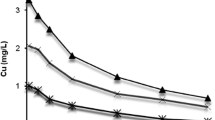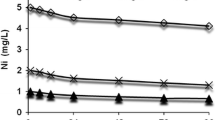Abstract
Bioaccumulation enables to integrate the ability of aquatic organisms to regulate metals and effects of water chemistry on metal bioavailability. Linking this process to biological responses offers thus promising lines of enquiry for protecting aquatic ecosystems. This study aims at characterizing the mechanisms involved in waterborne Cu bioaccumulation and assessing metal impact on digestive metabolism in an ecosystem engineer widely distributed in Europe, Gammarus pulex. The organism was exposed to several Cu concentrations (from 0.5 to 100 μg/L) in aquatic microcosms to establish kinetic parameters for the construction and comparison of two bioaccumulation models, i.e. the biodynamic and saturation models. Cu uptake was recorded in waters exhibiting various concentrations of Na, Mg and Ca at environmental levels to assess the influence of cationic composition on bioaccumulation. Then, the effect of increasing Cu in exposure media on the digestive metabolism of G. pulex was investigated by measuring enzymatic activities (β-glucosidase, N-acetyl-β-glucosaminidase, β-galactosidase). We showed that the saturation model is more suitable than the biodynamic model to describe Cu bioaccumulation in gammarids due to a maximal capacity of animals to accumulate the metal. Cationic composition of water affected insignificantly Cu uptake. All activities of tested enzymes decreased with increasing Cu in exposure media but with different degrees. High correlations were established between the inhibition of enzymatic activities and amounts of Cu bioaccumulated by gammarids. These biological responses could thus provide early-warming of Cu impact on aquatic biota.





Similar content being viewed by others
References
Ahearn GA, Mandal PK, Mandal A (2004) Mechanisms of heavy-metal sequestration and detoxification in crustaceans: a review. J Comp Physiol B 174:439–452
Alayse-Danet AM, Charlou JL, Jézéquel M, Samain JF (1979) Modèle de détection rapide des effets sublétaux des polluants: modification des taux d’amylase et de trypsine d’Artemia salina contaminée par le cuivre ou le zinc. Mar Biol 51:41–46
Atli G, Canli M (2011) Essential metal (Cu, Zn) exposures alter the activity of ATPases in gill, kidney and muscle of tilapia Oreochromis niloticus. Ecotoxicology 20:1861–1869
Boets P, Lock K, Goethals PL, Janssen CR, De Schamphelaere KA (2012) A comparison of the short-term toxicity of cadmium to indigenous and alien gammarid species. Ectoxicology 21:1135–1144
Borgmann U, Norwood WP (1995) Kinetics of excess (above background) copper and zinc in Hyalella azteca and their relationship to chronic toxicity. Can J Fish Aquat Sci 52:864–874
Borgmann U, Norwood WP, Dixon DG (2004) Re-evaluation of metal bioaccumulation and chronic toxicity in Hyalella azteca using saturation curves and the biotic ligand model. Environ Pollut 131(3):469–484
Borgmann U, Nowierski M, Dixon DG (2005) Effect of major ions on the toxicity of copper to Hyalella azteca and implications for the biotic ligand model. Aqua Toxicol 73:268–287
Bourgeault A, Gourlay-France C, Tusseau-Vuillemin MH (2010) Modeling the effect of water chemistry on the bioaccumulation of waterborne cadmium in zebra mussels. Environ Toxicol Chem 29:2182–2189
Brooks SJ, Lloyd Mills C (2003) The effect of copper on osmoregulation in the freshwater amphipod Gammarus pulex. Comp Biochem Physiol Mol Integrat Physiol 135:527–537
Chen Z, Mayer LM, Weston DP, Bock MJ, Jumars PA (2002) Inhibition of digestive enzyme activities by copper in the guts of various marine benthic invertebrates. Environ Toxicol Chem 21:1243–1248
Croteau MN, Luoma SN (2007) Characterizing dissolved Cu and Cd uptake in terms of the biotic ligand and biodynamics using enriched stable isotopes. Environ Sci Technol 41:3140–3145
De Coen WM, Janssen CR (1998) The use of biomarkers in Daphnia magna toxicity testing—I. The digestive physiology of daphnids exposed to toxic stress. Hydrobiologia 367:199–209
de Oliveira EC, Lopes RM, Paumgartten FJR (2004) Comparative study on the susceptibility of freshwater species to copper-based pesticides. Chemosphere 56:369–374
De Schamphelaere KAC, Janssen CR (2002) A biotic ligand model predicting acute copper toxicity for Daphnia magna: the effects of calcium, magnesium, sodium, potassium, and pH. Environ Sci Technol 36:48–54
De Schamphelaere KAC, Vasconcelos FM, Tack FMG, Allen HE, Janssen CR (2004) Effect of dissolved organic matter source on acute copper toxicity to Daphnia magna. Environ Toxicol Chem 23:1248–1255
Dedourge-Geffard O, Palais F, Biagianti-Risbourg S, Geffard O, Geffard A (2009) Effects of metals on feeding rate and digestive enzymes in Gammarus fossarum: an in situ experiment. Chemosphere 77:1569–1576
Felten V, Charmantier G, Mons R, Geffard A, Rousselle P, Coquery M, Garric J, Geffard O (2008) Physiological and behavioural responses of Gammarus pulex (Crustacea: amphipoda) exposed to cadmium. Aquat Toxicol 86:413–425
Ferreira D, Ciffroy P, Tusseau-Vuillemin M-H, Garnier C, Garnier J-M (2009) Modelling exchange kinetics of copper at the water-aquatic moss (Fontinalis antipyretica) interface: influence of water cationic composition (Ca, Mg, Na and pH). Chemosphere 74:1117–1124
Gaillardet J, Viers J, Dupré B (2004) Trace elements in river waters. Treatise on geochemistry: surface and ground water, weathering, and soils. Elsevier, Amsterdam, pp 225–272
Geffard A, Sartelet H, Garric J, Biagianti-Risbourg S, Delahaut L, Geffard O (2010) Subcellular compartmentalization of cadmium, nickel, and lead in Gammarus fossarum: comparison of methods. Chemosphere 78:822–829
Hoang TC, Rogevich EC, Rand GM, Frakes RA (2008) Copper uptake and depuration by juvenile and adult Florida apple snails (Pomacea paludosa). Ecotoxicology 17:605–615
Hyne RV, Maher WA (2003) Invertebrate biomarkers: links to toxicosis that predict population decline. Ecotox Environ Safe 54:366–374
Komjarova I, Blust R (2009) Effect of Na, Ca and pH on simultaneous uptake of Cd, Cu, Ni, Pb, and Zn in the water flea Daphnia magna measured using stable isotopes. Aquat Toxicol 94:81–86
Lebrun JD, Trinsoutrot-Gattin I, Laval K, Mougin C (2010) Insights into the development of fungal biomarkers for metal ecotoxicity assessment: case of Trametes versicolor exposed to copper. Environ Toxicol Chem 29:902–908
Lebrun JD, Perret M, Uher E, Tusseau-Vuillemin MH, Gourlay-France C (2011) Waterborne nickel bioaccumulation in Gammarus pulex: comparison of mechanistic models and influence of water cationic composition. Aquat Toxicol 104:161–167
Li N, Zhao YL, Yang J (2008) Effects of water-borne copper on digestive and metabolic enzymes of the giant freshwater prawn Macrobrachium rosenbergii. Arch Environ Contam Toxicol 55:86–93
Liu XJ, Ni IH, Wang WX (2002) Trophic transfer of heavy metals from freshwater zooplankton Daphnia magna to zebrafish Danio reiro. Water Res 36:4563–4569
Luoma SN, Rainbow PS (2005) Why is metal bioaccumulation so variable? Biodynamics as a unifying concept. Environ Sci Technol 39:1921–1931
Markich SJ, King AR, Wilson SP (2006) Non-effect of water hardness on the accumulation and toxicity of copper in a freshwater macrophyte (Ceratophyllum demersum): how useful are hardness-modified copper guidelines for protecting freshwater biota? Chemosphere 65:1791–1800
McGeer JC, Brix KV, Skeaff JM, DeForest DK, Brigham SI, Adams WJ, Green A (2003) Inverse relationship between bioconcentration factor and exposure concentration for metals: implications for hazard assessment of metals in the aquatic environment. Environ Toxicol Chem 22:1017–1037
Niyogi S, Wood CM (2004) Biotic ligand model, a flexible tool for developing site-specific water quality guidelines for metals. Environ Sci Technol 38:6177–6192
Pellet B, Geffard O, Lacour C, Kermoal T, Gourlay-Francé C, Tusseau-Vuillemin M-H (2009) A model predicting waterborne cadmium bioaccumulation in Gammarus pulex: the effects of dissolved organic ligands, calcium, and temperature. Environ Toxicol Chem 28:2434–2442
Rainbow PS (2002) Trace metal concentrations in aquatic invertebrates: why and so what? Environ Pollut 120:497–507
Rainbow PS (2007) Trace metal bioaccumulation: models, metabolic availability and toxicity. Environ Internat 33:576–582
Roussel H, Chauvet E, Bonzom JM (2008) Alteration of leaf decomposition in copper-contaminated freshwater mesocosms. Environ Toxicol Chem 27:637–644
Schaller J, Weiske A, Mkandawire M, Dudel EG (2010) Invertebrates control metals and arsenic sequestration as ecosystem engineers. Chemosphere 79:169–173
Schultheis AS, Sanchez M, Hendricks AC (1997) Structural and functional responses of stream insects to copper pollution. Hydrobiologia 346:85–93
Taylor HH, Anstiss JM (1999) Copper and haemocyanin dynamics in aquatic invertebrates. Mar Freshw Res 50:907–931
Tusseau-Vuillemin M-H, Gourlay C, Lorgeoux C, Mouchel J-M, Buzier R, Gilbin R, Seidel J-L, Elbaz-Poulichet F (2007) Dissolved and bioavailable contaminants in the Seine river basin. Sci Total Environ 375:244–256
Vinot I, Pihan JC (2005) Circulation of copper in the biotic compartments of a freshwater dammed reservoir. Environ Pollut 133:169–182
Worms I, Simon DF, Hassler CS, Wilkinson KJ (2006) Bioavailability of trace metals to aquatic microorganisms: importance of chemical, biological and physical processes on biouptake. Biochimie 88:1721–1731
Xu Q, Pascoe D (1993) The bioconcentration of zinc by Gammarus pulex (L) and the application of a kinetic-model to determine bioconcentration factors. Water Res 27:1683–1688
Acknowledgments
The authors wish to thank both the ONEMA (Office National de l’Eau et des Milieux Aquatiques) and the Région Ile-de-France for their financial support. We are also grateful to Ph.D. Christian Mougin (INRA Versailles, PESSAC Unity) for achievement of enzymatic assays.
Author information
Authors and Affiliations
Corresponding author
Rights and permissions
About this article
Cite this article
Lebrun, J.D., Perret, M., Geffard, A. et al. Modelling copper bioaccumulation in Gammarus pulex and alterations of digestive metabolism. Ecotoxicology 21, 2022–2030 (2012). https://doi.org/10.1007/s10646-012-0955-7
Accepted:
Published:
Issue Date:
DOI: https://doi.org/10.1007/s10646-012-0955-7




